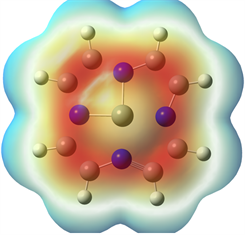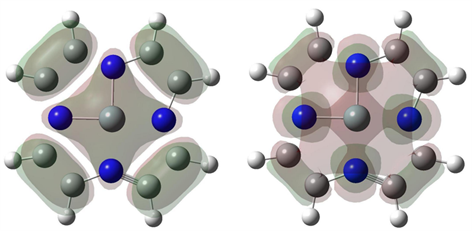Journal of Advances in Physical Chemistry
Vol.
11
No.
04
(
2022
), Article ID:
58233
,
5
pages
10.12677/JAPC.2022.114023
一类新型含平面四配位硅基化合物的 计算研究
缪田浩,丁津津*
南通大学化学化工学院,江苏 南通
收稿日期:2022年9月13日;录用日期:2022年11月16日;发布日期:2022年11月23日

摘要
研究了一类新型含平面四配位硅的化合物的分子结构与性质。选用较高精度的量子化学计算方法,密度泛函理论结合适中的基组,对计算结果进行静电势和前线轨道分析,表明这类含有平面四配位硅基化合物的分子具有稳定的电子和几何结构。
关键词
平面四配位分子,量子化学,高斯,静电势

Computational Study on a New Class of Silicon-Based Compounds Containing Planar Tetra-Coordination
Tianhao Miao, Jinjin Ding*
College of Chemistry and Chemical Engineering, Nantong University, Nantong Jiangsu
Received: Sep. 13th, 2022; accepted: Nov. 16th, 2022; published: Nov. 23rd, 2022

ABSTRACT
A new class of planar tetra-coordinate molecular structure and properties of silicon compounds were studied. High precision of calculation method of quantum chemistry and density functional theory combined with moderate base groups is selected to calculate the electrostatic potential and the frontier molecular orbital analysis results. The results show that this kind of containing planar tetra-coordinate molecules of silicon compounds has the stable electronic and geometric structures.
Keywords:Planar Tetra-Coordinate, Quantum Chemistry, Gaussian, Electrostatic Potential

Copyright © 2022 by author(s) and Hans Publishers Inc.
This work is licensed under the Creative Commons Attribution International License (CC BY 4.0).
http://creativecommons.org/licenses/by/4.0/


1. 引言
碳与硅都是世界上最重要的元素之一,而硅元素在地壳中的浓度甚至超过氧元素,它们都是各种特殊材料的重要原料。早在1874年,van’tHoff就提出了碳的四面体构型猜想,这一猜想很快被人们接受并被命名为ttC,后来甚至扩展到了硅,也就是ttSi。1970年,Hoffmann等采用近似计算法,对平面甲烷分子进行分析,提出了稳定含ptC化合物的构型。后来越来越多的含ptC分子化合物被成功制备,人们也越来越关注平面高配位碳体系,然而平面四配位硅的研究却一直受限 [1] - [7]。
C和Si是同族元素,但与平面四配位碳相比,人们对平面四配位硅的研究不多。在1979年,Würthwein等对含ptC和ptSi的分子进行了成键性质分析,他们发现ptC和ptSi不同,含ptSi分子的最高占据分子轨道为σ型,最低未占分子轨道为π型,因此只有将强的π电子给体和σ电子受体连接才能获得稳定的平面四配位结构。到了2000年,Boldyrev等首次发表了在实验中观察到的含ptSi的 与SiAl4团簇,其中阴离子和中性物质都有17或16个价电子且平面四配位硅均为梯形构型。而到2012年,Alexandrova等提出对这些团簇的几何结构的成型机理为体系共价性和芳香性的对抗,芳香性较强于共价性因此更加偏向于呈现平面构型,同时他们还预测了价电子数为14与18的系列团簇。2014年,Scheschkewitz等人成功将1,3-二硅烷-2-氧烯丙基硼烷加合物的结构晶体化,这很有可能是罕见的室温下就能存在的ptSi分子结构。下一年,通过大量的理论探索,Xu等设计了一系列含ptSi的分子。而到了2018年,第一例含ptSi的非金属配体分子终于由Ebner等实验合成——吡4咯氢化硅酸盐 [8] [9] [10] [11]。
之前的计算研究表明,二维层状材料中的ptSi的SiC12序列可以容纳16π电子并且出奇的稳定。但是被12π电子容纳的单体分子C12H8Si不能保持稳定的平面几何形状并略有扭曲。有趣的是,它那含有16π电子的锂络合物Li4C12H8Si,正如图1(a)所示是稳定的平面。在Li4C12H8Si中,每个锂原子配位到一个五元环。按照这一研究思路,人们设计了一系列的如图1(b)~(e)所示的修饰分子,每个分子都由相同的包含16π电子的ptSi平面共轭环构成,并通过振动频率计算进行了验证。为了方便起见,这些分子以Si-Y-XXXX的形式命名,其中X代表四个子环的成员数,Y等于共轭π电子的数量。值得注意的是,Si-16-5555 (图1(b))首先由Schleyer团队提出,之后由Szieberth等人研究。任何分子的平面化幅度如图1(f)所示用P来定义。对于所有a-e的分子,P = 100%就表示一个完美的平面构象。
图1中这些预期的ptSi分子最令人惊讶的特征是16π电子的共轭,这显然与传统的Huckel 4n + 2规则不一致。计算表明,大多数带有两个额外π电子(即18π电子)的ptSi分子仍然可以保持平面几何形状,而大多数带正电荷的带14π电子的ptSi分子不呈现平面几何形状。
以上这些理论和研究大大丰富了人们对ptSi结构的了解,但是目前对ptSi的结构和成键性质还有待深入研究,为此本文以量子化学理论为基础,选择了图1(b)的ptSi分子进行了计算结构优化及分析 [12] - [19]。

Figure 1. Structures of ptSi molecules
图1. ptSi分子结构
2. 平面四配位硅计算研究方法
本论文采用高斯软件 [20] 对平面四配位C8H8N4Si分子进行计算研究。高斯软件可以用于计算体系的基态或激发态的结构、反应能量、分子轨道、原子电荷的电势、振动频率、红外和拉曼光谱、核磁性质。结果可以预测研究体系的能量,结构和分子轨道。
可靠的计算方法及基组,适中的计算量是理论计算研究各种体系的首要条件。本论文采用选择B3LYP方法,6-31g基组,对C8H8N4Si分子进行结构优化、静电势分析以及前线轨道分析。利用GaussView和实现了分子轨道和分子静电势的可视化。
3. 结果与讨论
本论文选取图1(b)分子进行计算研究的初步分析,其分子结构见图1(b)。
3.1. 分子的静电势分析
静电势在分析分子间的相互作用力、分子间的反应部位以及分子识别方面都起着重要的作用。在静电势图中,分子表面不同静电势用不同的颜色表示,静电势值数据按红色 < 橙色 < 黄色 < 绿色 < 蓝色的顺序递增。C8H8N4Si分子的静电势见图2。

Figure 2. Molecular electrostatic potential distribution of C8H8N4Si
图2. C8H8N4Si的分子静电势分布
图2可以看出分子的碳环位置被负电荷集中包围,这说明可能有亲核攻击点位。此外,最外围氢元素主要是正电荷分布区域。
3.2. 前线分子轨道分析
最高占有分子轨道(HOMO)和最低占有分子轨道(LUMO)是参与分子内电荷转移的主要分子轨道。这两个轨道决定着分子的电子得失和转移能力,决定着分子各类重要的化学性质。HOMO与LUMO能极差大小能够反映电子从占据轨道向空轨道跃迁的能力,所以一定程度上能够反映出分子参与化学反应能力的强弱。能极差越大,则说明电子越不容易发生跃迁,表示分子就越稳定。因此研究这两个轨道的能量及能级差对研究分子的性质有非常重要的意义。
我们选用B3LYP方法和6-31g基组来优化C8H8N4Si的结构并且得到如图3所示的进行结构优化后得到的分子前线分子轨道能级对比图。

Figure 3. Frontier molecular orbitals of optimized C8H8N4Si
图3. 优化后的C8H8N4Si的前线分子轨道图
表1是对C8H8N4Si分子采用B3LYP方法与6-311g组分的组合所优化后得到的分子轨道能量进行整理。从表1中的数据可以看出该分子的前线轨道能量差为4.54 ev,大于2 ev,说明该分子不易发生分子内电子跃迁,具有良好的分子稳定性。
Table 1. Frontier molecular orbital energy of optimized C8H8N4Si
表1. C8H8N4Si分子优化后的前线分子轨道能量
4. 结论
本论文采用较高精度的密度泛函理论量子化学计算方法,结合适中的基组,对一种平面四配位硅分子进行了一系列计算研究。本论文计算了C8H8N4Si分子的最优构型,静电势以及前线分子轨道。通过计算结果的静电势分析,看出分子的碳环位置被负电荷集中包围,这说明可能有亲核攻击点位。此外,最外围氢元素主要是正电荷分布区域。进一步地,通过对激发态轨道跃迁的分析,可以看出该分子的前线轨道能量差大于2 ev,说明该分子不易发生分子内电子跃迁,具有良好的分子稳定性。本工作是用量子化学计算方法研究平面四配位硅分子的各种性质的初步探索,接下来我们将继续深入研究分析不同配位数的平面分子,在此基础上创新本组的相关理论计算研究工作,以期为该领域提供系统而有价值的理论参考,通过模拟设计出新型平面分子,成为该领域发展方向的理论指引。
文章引用
缪田浩,丁津津. 一类新型含平面四配位硅基化合物的计算研究
Computational Study on a New Class of Silicon-Based Compounds Containing Planar Tetra-Coordination[J]. 物理化学进展, 2022, 11(04): 209-213. https://doi.org/10.12677/JAPC.2022.114023
参考文献
- 1. van’t Hoff, J.H. (1874) Sur les formules de strucutre dans I’espace. Archives Neerlandaises des Sciences Exactes et Naturelles, 9, 445-454.
- 2. Pauling, L.C. (1960) The Nature of the Chemical Bond. 3rd Edition, Cornell University Press, Ithaca.
- 3. Hoffmann, R., Alder, R.W. and Wilcox, C.F. (1970) Planar Tetracoordinate Carbon. Journal of the American Chemical Society, 92, 4992-4993. https://doi.org/10.1021/ja00719a044
- 4. Boldyrev, A.I. and Simons, J. (1998) Tetracoordinated Planar Carbon in Pentaatomic Molecules. Journal of the American Chemical Society, 120, 7967-7972. https://doi.org/10.1021/ja981236u
- 5. Wang, Z.-X. and Schleyer, P.R. (2001) Families of Molecules with Planar Pentacoordinate Carbons, Science, 292, 2465-2469. https://doi.org/10.1126/science.1060000
- 6. Fang, L., Lu, X., Mo, X., Zhang, X. and Gui, C. (2022) Performance of Impregnated Paper Decorated Blockboard Manufactured Using HDF as Equilibrium Layer. Materials (Basel), 15, 6342-6350. https://doi.org/10.3390/ma15186342
- 7. Justo Alonso, M., Moazami, T.N., Liu, P., Jørgensen, R.B. and Mathisen, H.M. (2022) Assessing the Indoor Air Quality and Their Predictor Variable in 21 Home Offices during the Covid-19 Pandemic in Norway. Building and Environment, 225, 109580-109589. https://doi.org/10.1016/j.buildenv.2022.109580
- 8. Surawattanasakul, V., Sirikul, W., Sapbamrer, R., et al. (2022) Respiratory Symptoms and Skin Sick Building Syndrome among Office Workers at University Hospital, Chiang Mai, Thailand: Associations with Indoor Air Quality, AIRMED Project. International Journal of Environmental Research and Public Health, 19, 10850-10859. https://doi.org/10.3390/ijerph191710850
- 9. Zhang, L., Bao, Q., Zhang, B., et al. (2022) Distinct Role of Surface Hydroxyls in Single-Atom Pt1/CeO2 Catalyst for Room-Temperature Formaldehyde Oxidation: Acid-Base versus Redox. JACS Au, 2, 1651-1660. https://doi.org/10.1021/jacsau.2c00215
- 10. Yuan, W., Wu, Y., Qi, T., Wan, Y., et al. (2022) Novel B and N Sites of One-Dimensional Boron Nitride Fiber: Efficient Performance and Mechanism in the Formaldehyde Capture Process. ACS Omega, 7, 25686-25692. https://doi.org/10.1021/acsomega.2c02920
- 11. Collins, J.B., Dill, J.D., Jemmis, E.D., Apeloig, Y., Schleyer, P.R., Seeger, R. and Pople, J.A. (1976) Stabilization of Planar Tetracoordinate Carbon. Journal of the American Chemical Society, 98, 5419-5427. https://doi.org/10.1021/ja00434a001
- 12. Erker, G. (1999) Using Bent Metallocenes for Stabilizing Unusual Coordination Geometries at Carbon. Chemical Society Reviews, 28, 307-314. https://doi.org/10.1039/a708611c
- 13. Rçttger, D. and Erker, G. (1997) Compounds Containing Planar-Tetracoordinate Carbon. Angewandte Chemie International Edition in English, 36, 812-827. https://doi.org/10.1002/anie.199708121
- 14. Cooper, O.J., Wooles, A.J., McMaster, J., Lewis, W., Blake, A.J. and Liddle, S.T. (2010) A Monomeric Dilithio Methandiide with a Distorted Trans-Planar Four-Coordinate Carbon. Angewandte Chemie International Edition, 49, 5570-5573. https://doi.org/10.1002/anie.201002483
- 15. Yoshizawa, K. and Suzuki, A. (2001) Configurational Inversion of the Tetrahedral Molecules CH4, SiH4, and GeH4. Chemical Physics, 271, 41-54. https://doi.org/10.1016/S0301-0104(01)00432-3
- 16. Alexandrova, A.N., Nayhouse, M.J., Huynh, M.T., et al. (2012) Selected AB42−/− (A = C, Si, Ge; B = Al, Ga, In) Ions: a Battle between Covalency and Aromaticity, and Prediction of Square Planar Si in SiIn42−/−. Physical Chemistry Chemical Physics, 14, 14815-14821. https://doi.org/10.1039/c2cp41821e
- 17. Chandrasekhar, J., Werthwein, E.-U. and Von Ragu Schleyer, P. (1981) On the Planarity of Tetracoordinate Carbon Enclosed by Annulene Perimeters. Tetrahedron, 37, 921-927. https://doi.org/10.1016/S0040-4020(01)97661-6
- 18. Szieberth, D., Takahashi, M. and Kawazoe, Y. (2009) Stabilization of Square Planar Silicon: A New Building Block for Conjugated Si-Containing Systems. The Journal of Physical Chemistry A, 113, 707-712. https://doi.org/10.1021/jp806053e
- 19. Boldyrev, A.I., von Ragu Schleyer, P. and Keese, R. (1992) Planar Tetracoordinated Silicon and Phosphorus Geometries in Poiynitrogen-Substituted [5.5.5.5]Fenestrenes. Mendeleev Communications, 2, 93-95. https://doi.org/10.1070/MC1992v002n03ABEH000149
- 20. Frisch, M.J., Trucks, G.W., Schlegel, H.B., et al. (2009) Gaussian09, Revision D. 01. Gaussian Inc., Wallingford.
NOTES
*通讯作者。
